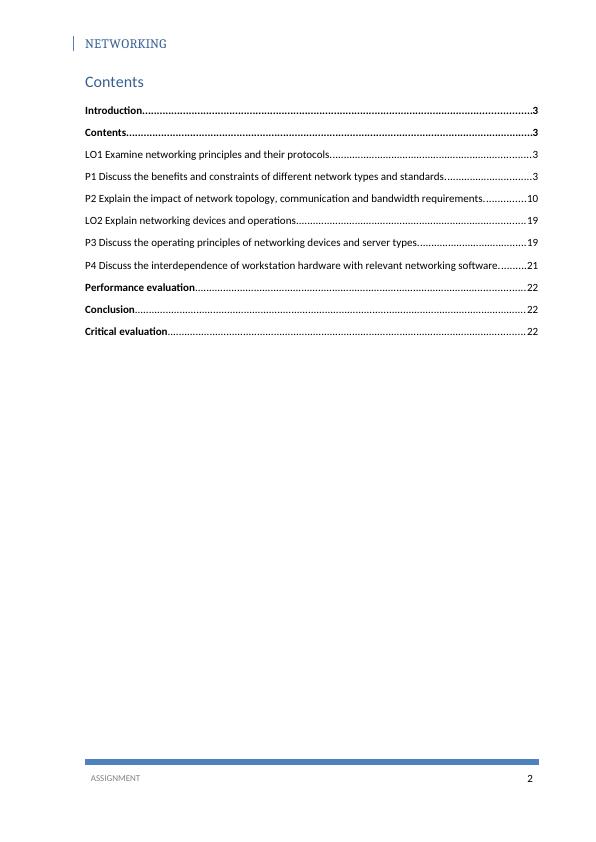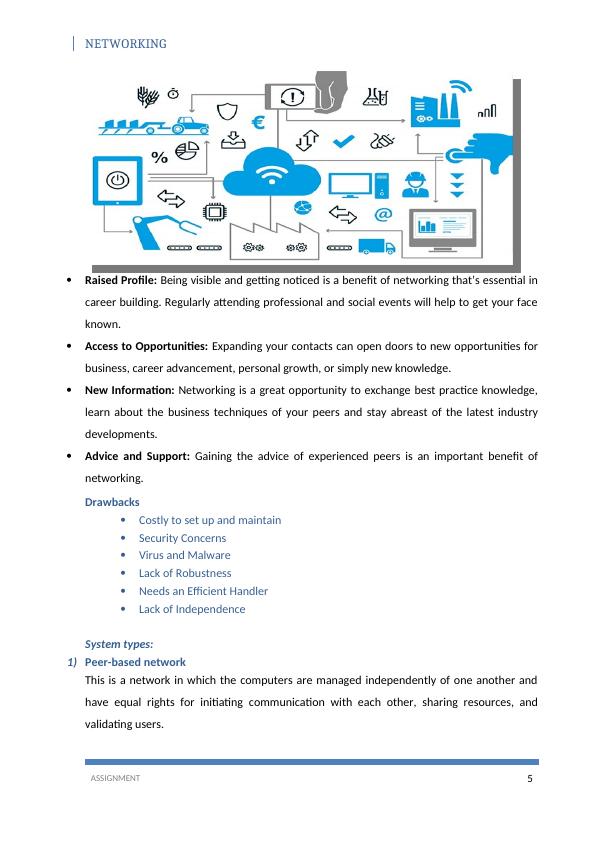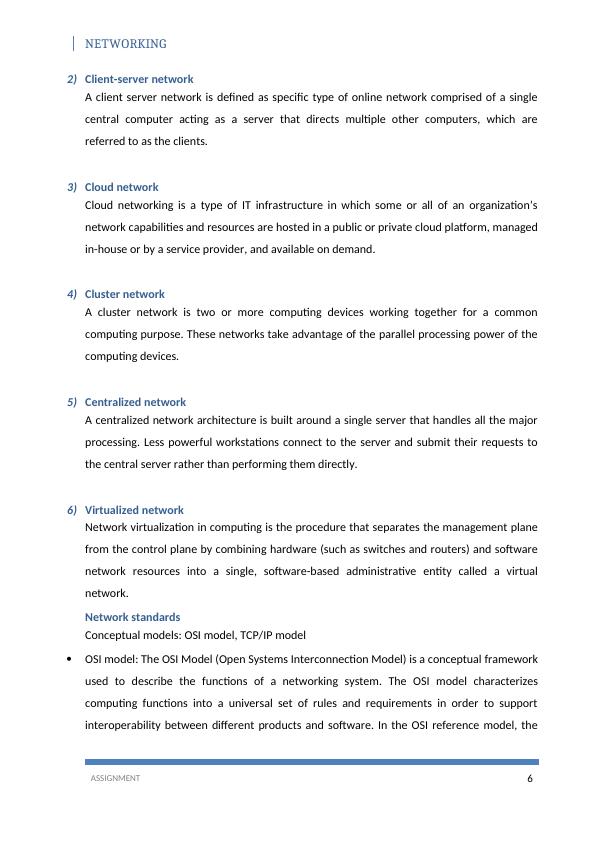Ask a question from expert
LO1 Examine networking principles and their protocols
33 Pages6140 Words1532 Views
Added on 2021-10-01
LO1 Examine networking principles and their protocols
Added on 2021-10-01
BookmarkShareRelated Documents
NETWORKING
PROGRAM TITLE: NETWORK INFORMATION
UNIT TITLE: NETWORKING
ASSIGNMENT NUMBER: 1
ASSIGNMENT NAME: NETWORK INFORMATION
SUBMISSION DATE: 11/2020
DATE RECEIVED: 10/11/2020
TUTORIAL LECTURER: TRAN HOANG BACH
WORD COUNT: 5501
STUDENT NAME: NGO VAN HUY
STUDENT ID: BKD18400
MOBILE NUMBER: 0383930441
ASSIGNMENT 1
PROGRAM TITLE: NETWORK INFORMATION
UNIT TITLE: NETWORKING
ASSIGNMENT NUMBER: 1
ASSIGNMENT NAME: NETWORK INFORMATION
SUBMISSION DATE: 11/2020
DATE RECEIVED: 10/11/2020
TUTORIAL LECTURER: TRAN HOANG BACH
WORD COUNT: 5501
STUDENT NAME: NGO VAN HUY
STUDENT ID: BKD18400
MOBILE NUMBER: 0383930441
ASSIGNMENT 1

NETWORKING
Contents
Introduction......................................................................................................................................3
Contents............................................................................................................................................3
LO1 Examine networking principles and their protocols........................................................................3
P1 Discuss the benefits and constraints of different network types and standards...............................3
P2 Explain the impact of network topology, communication and bandwidth requirements...............10
LO2 Explain networking devices and operations..................................................................................19
P3 Discuss the operating principles of networking devices and server types.......................................19
P4 Discuss the interdependence of workstation hardware with relevant networking software..........21
Performance evaluation......................................................................................................................22
Conclusion............................................................................................................................................22
Critical evaluation................................................................................................................................22
ASSIGNMENT 2
Contents
Introduction......................................................................................................................................3
Contents............................................................................................................................................3
LO1 Examine networking principles and their protocols........................................................................3
P1 Discuss the benefits and constraints of different network types and standards...............................3
P2 Explain the impact of network topology, communication and bandwidth requirements...............10
LO2 Explain networking devices and operations..................................................................................19
P3 Discuss the operating principles of networking devices and server types.......................................19
P4 Discuss the interdependence of workstation hardware with relevant networking software..........21
Performance evaluation......................................................................................................................22
Conclusion............................................................................................................................................22
Critical evaluation................................................................................................................................22
ASSIGNMENT 2

NETWORKING
Summative Feedback:
Internal verification:
ASSIGNMENT 3
Summative Feedback:
Internal verification:
ASSIGNMENT 3

NETWORKING
A.Introduction
In my report, I am going a detailed guide that outlines the principles, models, and network
equipment for network training purposes and outlines the sections of the manual that are
relevant to Brick Lane. My main content is inside part II (Contents). I will show about
communication skills, problem-solving skills, time management skills and critical reasoning
and the importance of them are. In part III is my conclusion in this report, parts I finished. In
part IV, I will show what I did and not, I will evaluate the point of my report. Finally, in part V
is references that are sources I refer on.
B.Contents
LO1 Examine networking principles and their protocols
P1 Discuss the benefits and constraints of different network types and standards
What is a network?
In information technology, a network is defined as the connection of at least two computer
systems, either by a cable or a wireless connection. The simplest network is a combination of
two computers connected by a cable. This type of network is called a peer-to-peer network.
There is no hierarchy in this network; both participants have equal privileges. Each computer
has access to the data of the other device and can share resources such as disk space,
applications or peripheral devices (printers, etc.).
Computer network
Computer networks are the basis of communication in IT. They are used in a huge variety of
ways and can include many different types of network. A computer network is a set of
computers that are connected together so that they can share information.
Benefits of networks
There are various benefits that are achieved in a networked environment they include:
Strengthening Relationships: Networking is about sharing, not taking. It is about forming
trust and helping one another toward goals.
Fresh Ideas: Your network can be an excellent source of new perspectives and ideas to help
you in your role.
ASSIGNMENT 4
A.Introduction
In my report, I am going a detailed guide that outlines the principles, models, and network
equipment for network training purposes and outlines the sections of the manual that are
relevant to Brick Lane. My main content is inside part II (Contents). I will show about
communication skills, problem-solving skills, time management skills and critical reasoning
and the importance of them are. In part III is my conclusion in this report, parts I finished. In
part IV, I will show what I did and not, I will evaluate the point of my report. Finally, in part V
is references that are sources I refer on.
B.Contents
LO1 Examine networking principles and their protocols
P1 Discuss the benefits and constraints of different network types and standards
What is a network?
In information technology, a network is defined as the connection of at least two computer
systems, either by a cable or a wireless connection. The simplest network is a combination of
two computers connected by a cable. This type of network is called a peer-to-peer network.
There is no hierarchy in this network; both participants have equal privileges. Each computer
has access to the data of the other device and can share resources such as disk space,
applications or peripheral devices (printers, etc.).
Computer network
Computer networks are the basis of communication in IT. They are used in a huge variety of
ways and can include many different types of network. A computer network is a set of
computers that are connected together so that they can share information.
Benefits of networks
There are various benefits that are achieved in a networked environment they include:
Strengthening Relationships: Networking is about sharing, not taking. It is about forming
trust and helping one another toward goals.
Fresh Ideas: Your network can be an excellent source of new perspectives and ideas to help
you in your role.
ASSIGNMENT 4

NETWORKING
Raised Profile: Being visible and getting noticed is a benefit of networking that’s essential in
career building. Regularly attending professional and social events will help to get your face
known.
Access to Opportunities: Expanding your contacts can open doors to new opportunities for
business, career advancement, personal growth, or simply new knowledge.
New Information: Networking is a great opportunity to exchange best practice knowledge,
learn about the business techniques of your peers and stay abreast of the latest industry
developments.
Advice and Support: Gaining the advice of experienced peers is an important benefit of
networking.
Drawbacks
Costly to set up and maintain
Security Concerns
Virus and Malware
Lack of Robustness
Needs an Efficient Handler
Lack of Independence
System types:
1) Peer-based network
This is a network in which the computers are managed independently of one another and
have equal rights for initiating communication with each other, sharing resources, and
validating users.
ASSIGNMENT 5
Raised Profile: Being visible and getting noticed is a benefit of networking that’s essential in
career building. Regularly attending professional and social events will help to get your face
known.
Access to Opportunities: Expanding your contacts can open doors to new opportunities for
business, career advancement, personal growth, or simply new knowledge.
New Information: Networking is a great opportunity to exchange best practice knowledge,
learn about the business techniques of your peers and stay abreast of the latest industry
developments.
Advice and Support: Gaining the advice of experienced peers is an important benefit of
networking.
Drawbacks
Costly to set up and maintain
Security Concerns
Virus and Malware
Lack of Robustness
Needs an Efficient Handler
Lack of Independence
System types:
1) Peer-based network
This is a network in which the computers are managed independently of one another and
have equal rights for initiating communication with each other, sharing resources, and
validating users.
ASSIGNMENT 5

NETWORKING
2) Client-server network
A client server network is defined as specific type of online network comprised of a single
central computer acting as a server that directs multiple other computers, which are
referred to as the clients.
3) Cloud network
Cloud networking is a type of IT infrastructure in which some or all of an organization’s
network capabilities and resources are hosted in a public or private cloud platform, managed
in-house or by a service provider, and available on demand.
4) Cluster network
A cluster network is two or more computing devices working together for a common
computing purpose. These networks take advantage of the parallel processing power of the
computing devices.
5) Centralized network
A centralized network architecture is built around a single server that handles all the major
processing. Less powerful workstations connect to the server and submit their requests to
the central server rather than performing them directly.
6) Virtualized network
Network virtualization in computing is the procedure that separates the management plane
from the control plane by combining hardware (such as switches and routers) and software
network resources into a single, software-based administrative entity called a virtual
network.
Network standards
Conceptual models: OSI model, TCP/IP model
OSI model: The OSI Model (Open Systems Interconnection Model) is a conceptual framework
used to describe the functions of a networking system. The OSI model characterizes
computing functions into a universal set of rules and requirements in order to support
interoperability between different products and software. In the OSI reference model, the
ASSIGNMENT 6
2) Client-server network
A client server network is defined as specific type of online network comprised of a single
central computer acting as a server that directs multiple other computers, which are
referred to as the clients.
3) Cloud network
Cloud networking is a type of IT infrastructure in which some or all of an organization’s
network capabilities and resources are hosted in a public or private cloud platform, managed
in-house or by a service provider, and available on demand.
4) Cluster network
A cluster network is two or more computing devices working together for a common
computing purpose. These networks take advantage of the parallel processing power of the
computing devices.
5) Centralized network
A centralized network architecture is built around a single server that handles all the major
processing. Less powerful workstations connect to the server and submit their requests to
the central server rather than performing them directly.
6) Virtualized network
Network virtualization in computing is the procedure that separates the management plane
from the control plane by combining hardware (such as switches and routers) and software
network resources into a single, software-based administrative entity called a virtual
network.
Network standards
Conceptual models: OSI model, TCP/IP model
OSI model: The OSI Model (Open Systems Interconnection Model) is a conceptual framework
used to describe the functions of a networking system. The OSI model characterizes
computing functions into a universal set of rules and requirements in order to support
interoperability between different products and software. In the OSI reference model, the
ASSIGNMENT 6

NETWORKING
communications between a computing system are split into seven different abstraction
layers: Physical, Data Link, Network, Transport, Session, Presentation, and Application.
TCP/IP model: TCP/IP, or the Transmission Control Protocol/Internet Protocol, is a suite of
communication protocols used to interconnect network devices on the internet. TCP/IP can
also be used as a communications protocol in a private computer network(an intranet or an
extranet).
- The following are the similarities between the OSI and TCP/IP model:
Both the reference models are based upon layered architecture.
The layers in the models are compared with each other. The physical layer and the data link
layer of the OSI model correspond to the link layer of the TCP/IP model. The network layers
and the transport layers are the same in both the models. The session layer, the
presentation layer and the application layer of the OSI model together form the application
layer of the TCP/IP model.
In both the models, protocols are defined in a layer-wise manner.
In both models, data is divided into packets and each packet may take the individual route
from the source to the destination.
ASSIGNMENT 7
communications between a computing system are split into seven different abstraction
layers: Physical, Data Link, Network, Transport, Session, Presentation, and Application.
TCP/IP model: TCP/IP, or the Transmission Control Protocol/Internet Protocol, is a suite of
communication protocols used to interconnect network devices on the internet. TCP/IP can
also be used as a communications protocol in a private computer network(an intranet or an
extranet).
- The following are the similarities between the OSI and TCP/IP model:
Both the reference models are based upon layered architecture.
The layers in the models are compared with each other. The physical layer and the data link
layer of the OSI model correspond to the link layer of the TCP/IP model. The network layers
and the transport layers are the same in both the models. The session layer, the
presentation layer and the application layer of the OSI model together form the application
layer of the TCP/IP model.
In both the models, protocols are defined in a layer-wise manner.
In both models, data is divided into packets and each packet may take the individual route
from the source to the destination.
ASSIGNMENT 7

NETWORKING
- Differences between OSI and TCP / IP Reference Models:
Standards: IEEE 802
IEEE 802 is a collection of networking standards that cover the physical and data-link layer
specifications for technologies such as Ethernet and wireless. These specifications apply to
local area networks (LAN) and metropolitan area networks (MAN). IEEE 802 also aids in
ensuring multi-vendor interoperability by promoting standards for vendors to follow.
ASSIGNMENT 8
- Differences between OSI and TCP / IP Reference Models:
Standards: IEEE 802
IEEE 802 is a collection of networking standards that cover the physical and data-link layer
specifications for technologies such as Ethernet and wireless. These specifications apply to
local area networks (LAN) and metropolitan area networks (MAN). IEEE 802 also aids in
ensuring multi-vendor interoperability by promoting standards for vendors to follow.
ASSIGNMENT 8

End of preview
Want to access all the pages? Upload your documents or become a member.
Related Documents
Unit 2 : Networking Infrastructure - Assignmentlg...
|26
|8992
|888
Network Principles and Protocolslg...
|13
|3704
|69
Benefit and Constraint of Different Network Typeslg...
|31
|5489
|58
BTEC Level 5 HND Diploma in Computing Assignment 2022lg...
|31
|4931
|24
Computer Networking and Internet Protocolslg...
|8
|1008
|334
(solved) Assignment on Networkinglg...
|27
|5649
|353